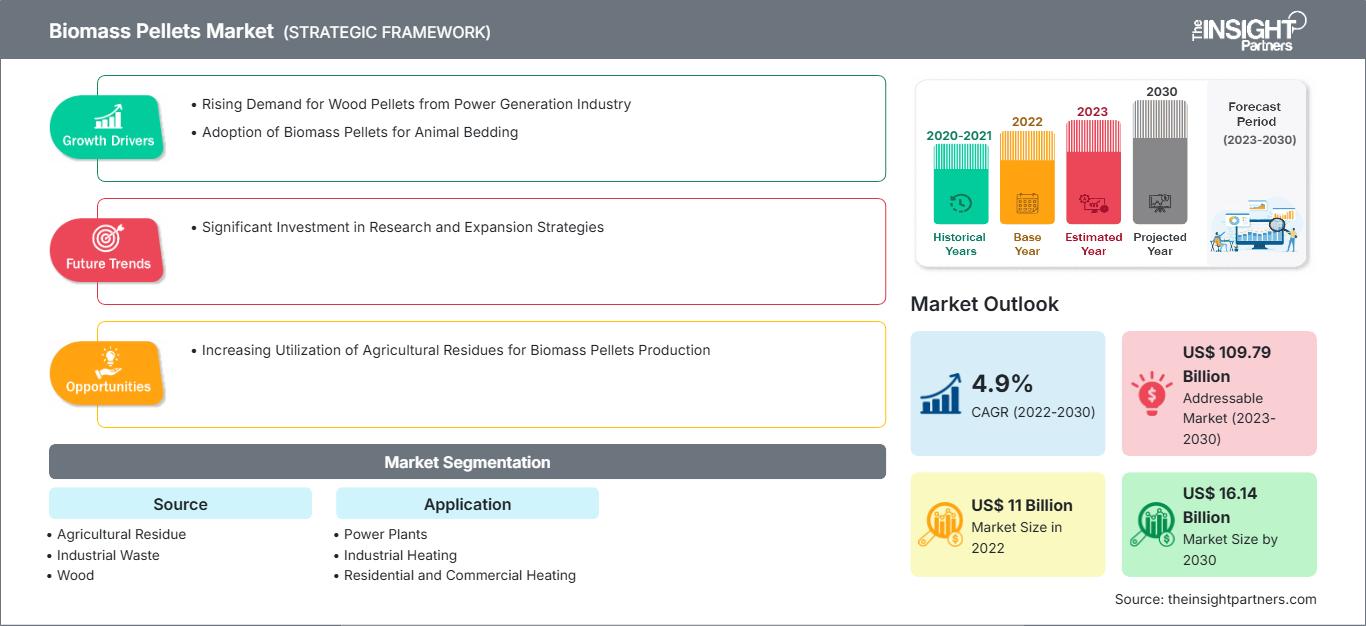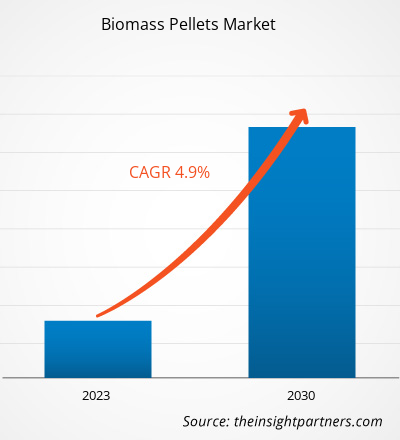[Informe de investigación] El tamaño del mercado de pellets de biomasa se valoró en US$ 11.001,59 millones en 2022 y se espera que alcance los US$ 16.137,89 millones para 2030; se estima que registrará una CAGR del 4,9% de 2022 a 2030.
Perspectivas del mercado y opinión de los analistas:
Los pellets de biomasa son biomasa procesada de alta densidad, comprimida en pequeños cilindros. Se derivan de materiales orgánicos, como residuos agrícolas, desechos de madera, astillas de madera, serrín y residuos forestales. Se utilizan en la generación de energía y en aplicaciones de calefacción en los sectores residencial, comercial e industrial. Presentan numerosas ventajas sobre la biomasa sin procesar, como sus características estandarizadas, su alto contenido energético, su viabilidad de almacenamiento y su facilidad de transporte. Los pellets de biomasa, en concreto los de madera, se utilizan ampliamente en estufas y calderas de pellets residenciales. Los esfuerzos del gobierno para reducir las emisiones de gases de efecto invernadero y promover el uso de pellets de biomasa están impulsando el crecimiento del mercado de pellets de biomasa.
Factores impulsores del crecimiento y desafíos:
Con la creciente atención a la sostenibilidad, la demanda de pellets de biomasa, como los de madera, ha aumentado significativamente. Los pellets de madera pueden utilizarse para la producción de electricidad como alternativa al carbón como materia prima. Además, los pellets de biomasa tienen una forma uniforme, una alta densidad y son fáciles de transportar y almacenar. La demanda de pellets de madera ha crecido considerablemente para aplicaciones de generación de energía. En Europa y Norteamérica, así como en países asiáticos como China, Japón y Corea del Sur, los pellets de madera se utilizan principalmente para la co-combustión en centrales eléctricas de carbón. Existe un aumento en el uso de materiales alternativos al carbón en centrales eléctricas a gran escala en todo el mundo. En 2021, el Ministerio de Energía de la India exigió la utilización de al menos un 5% de pellets de biomasa en la mezcla de combustible con carbón en todas las centrales eléctricas de carbón. Estas exigencias están impulsando el crecimiento del mercado de pellets de biomasa en la India. Además, las grandes compañías eléctricas de varios países europeos, como los Países Bajos y Bélgica, obtuvieron pellets de biomasa de Estados Unidos, Rusia y Canadá, según el Departamento de Agricultura de Estados Unidos. Por lo tanto, la creciente demanda de pellets de madera en la industria de generación de energía está impulsando el mercado de pellets de biomasa. Estos pellets se derivan de materiales orgánicos como madera, residuos agrícolas y desechos industriales. Muchos países los consideran una fuente de combustible sostenible; sin embargo, existen diversas preocupaciones ambientales relacionadas con ellos. La combustión de pellets de biomasa libera contaminantes al aire, como partículas, óxidos de nitrógeno y compuestos orgánicos volátiles. Además, la producción de biomasa implica un consumo significativo de agua para su procesamiento. Por lo tanto, las preocupaciones ambientales relacionadas con los pellets de biomasa están frenando el crecimiento de su mercado.
Personalice este informe según sus necesidades
Obtendrá personalización en cualquier informe, sin cargo, incluidas partes de este informe o análisis a nivel de país, paquete de datos de Excel, así como también grandes ofertas y descuentos para empresas emergentes y universidades.
Mercado de pellets de biomasa: Perspectivas estratégicas

- Obtenga las principales tendencias clave del mercado de este informe.Esta muestra GRATUITA incluirá análisis de datos, desde tendencias del mercado hasta estimaciones y pronósticos.
Segmentación y alcance del informe:
El mercado global de pellets de biomasa está segmentado según su origen, aplicación y ubicación geográfica. Según su origen, se divide en residuos agrícolas, residuos industriales, madera, entre otros. Según su aplicación, se divide en centrales eléctricas, calefacción industrial, calefacción residencial y comercial, entre otros. Geográficamente, se divide en América del Norte (EE. UU., Canadá y México), Europa (Alemania, Francia, Italia, Reino Unido, Rusia y resto de Europa), Asia Pacífico (Australia, China, Japón, India, Corea del Sur y resto de Asia Pacífico), Oriente Medio y África (Sudáfrica, Arabia Saudita, Emiratos Árabes Unidos y resto de Oriente Medio y África), y América del Sur y Central (Brasil, Argentina y resto de América del Sur y Central).
Análisis segmentario:
Según su origen, el mercado de pellets de biomasa se segmenta en residuos agrícolas, residuos industriales, madera y otros. El segmento de la madera ocupó la mayor cuota de mercado y se espera que registre un crecimiento significativo durante el período de pronóstico. Los pellets de biomasa se fabrican a partir de residuos de madera como aserrín, astillas, virutas, corteza y otros materiales residuales generados en la carpintería, los aserraderos y el procesamiento de la madera. Los residuos de madera se recolectan, procesan, secan y peletizan. Los pellets de biomasa de madera se utilizan ampliamente en aplicaciones de calefacción residencial, hornos industriales y centrales eléctricas.
Análisis regional:
Según la geografía, el mercado de pellets de biomasa se segmenta en cinco regiones clave: Norteamérica, Europa, Asia Pacífico, Sudamérica y Centroamérica, y Oriente Medio y África. El mercado mundial de pellets de biomasa estuvo dominado por Europa, que representó aproximadamente 6.478 millones de dólares estadounidenses en 2022. Asia Pacífico es el segundo mayor contribuyente, con más del 30 % de la cuota de mercado mundial de pellets de biomasa ese mismo año. Se espera que Norteamérica registre una tasa de crecimiento anual compuesta (TCAC) superior al 4,5 % durante el período de pronóstico. En Norteamérica, el mercado de pellets de biomasa está impulsado significativamente por la competitividad regional de los costes de los pellets de biomasa en comparación con el gasóleo para calefacción residencial y el propano. La producción de pellets de madera en Norteamérica ha cobrado impulso en los últimos años debido a la creciente demanda de los mercados extranjeros. Según el Departamento de Agricultura de Estados Unidos, Estados Unidos y Canadá suministran pellets de madera a centrales eléctricas de los Países Bajos y Bélgica. El aumento de la demanda interna de pellets de biomasa en la región ha impulsado a los fabricantes a ampliar su capacidad de producción. En 2023, Grand River Pellets (Canadá) invirtió US$30 millones para ampliar su capacidad de producción de pellets de biomasa de 140.000 a 220.000 toneladas métricas anuales. Todos estos factores impulsan el crecimiento del mercado de pellets de biomasa en Norteamérica.
Desarrollos de la industria y oportunidades futuras:
A continuación se enumeran varias iniciativas adoptadas por los actores clave que operan en el mercado de pellets de biomasa:
- En septiembre de 2022, Enviva Inc. inauguró su nueva planta de fabricación de pellets de madera en el condado de George, Misisipi (EE. UU.). La planta inició sus actividades de producción a principios de 2022 para alcanzar una capacidad de producción anual permitida de 750.000 toneladas métricas al año (TMPA).
- En abril de 2022, Drax Group PLC inauguró una nueva planta de pellets en Demopolis, Alabama, EE. UU. La planta produce anualmente pellets de biomasa sostenible a partir de residuos de aserraderos, como aserrín, astillas y virutas.
- En diciembre de 2020, Pure Biofuel Ltd. lanzó los pellets de madera ENPOWER. Las bolsas de pellets de madera ENPOWER cumplen con los estándares de calidad A1, establecidos por el Consejo de Pellets del Reino Unido y el Consejo Europeo. Este producto está disponible en paquetes de 10 y 15 kg.
- En abril de 2021, Drax Group PLC adquirió Pinnacle Renewable Energy Inc. Con la adquisición, Drax Group PLC entregó bioenergía con captura y almacenamiento de carbono (BECCS), eliminando permanentemente el dióxido de carbono de la atmósfera cada año.
- En mayo de 2023, el Grupo LEAG adquirió Wismar Pellets GmbH de Metropolitan Equity Partners, un inversor de capital privado, en un proceso de licitación para ampliar la cartera de producción y suministro de sus operaciones de refinación. Esta adquisición permitirá al Grupo LEAG atender a un mayor número de clientes.
Perspectivas regionales del mercado de pellets de biomasa
Los analistas de The Insight Partners han explicado detalladamente las tendencias regionales y los factores que influyen en el mercado de pellets de biomasa durante el período de pronóstico. Esta sección también analiza los segmentos y la geografía del mercado de pellets de biomasa en América del Norte, Europa, Asia Pacífico, Oriente Medio y África, y América del Sur y Central.
Alcance del informe de mercado de pellets de biomasa
| Atributo del informe | Detalles |
|---|---|
| Tamaño del mercado en 2022 | 11 mil millones de dólares estadounidenses |
| Tamaño del mercado en 2030 | US$ 16.14 mil millones |
| CAGR global (2022-2030) | 4,9% |
| Datos históricos | 2020-2021 |
| Período de pronóstico | 2023-2030 |
| Segmentos cubiertos | Por fuente
|
| Regiones y países cubiertos | América del norte
|
| Líderes del mercado y perfiles de empresas clave |
|
Densidad de los actores del mercado de pellets de biomasa: comprensión de su impacto en la dinámica empresarial
El mercado de pellets de biomasa está creciendo rápidamente, impulsado por la creciente demanda del usuario final debido a factores como la evolución de las preferencias de los consumidores, los avances tecnológicos y un mayor conocimiento de los beneficios del producto. A medida que aumenta la demanda, las empresas amplían su oferta, innovan para satisfacer las necesidades de los consumidores y aprovechan las tendencias emergentes, lo que impulsa aún más el crecimiento del mercado.

- Obtenga una descripción general de los principales actores clave del mercado de pellets de biomasa
Impacto del COVID-19:
La pandemia de COVID-19 afectó a casi todas las industrias en varios países. Los confinamientos, las restricciones de viaje y los cierres comerciales en América del Norte, Europa, Asia Pacífico (APAC), América del Sur y Central, y Oriente Medio y África (MEA) obstaculizaron el crecimiento de varias industrias, incluida la industria química y de materiales. El cierre de las unidades de fabricación de las empresas de pellets de biomasa perturbó las cadenas de suministro globales, las actividades de fabricación y los plazos de entrega. Varias empresas experimentaron retrasos en las entregas de productos y una caída en las ventas de sus productos en 2020. La mayoría de las centrales eléctricas y plantas industriales cerraron durante la pandemia, lo que disminuyó el consumo de pellets de biomasa. Además, la pandemia ha provocado fluctuaciones en los precios de los pellets de biomasa. Sin embargo, varias industrias reanudaron sus operaciones después de que se resolvieron las restricciones de suministro. Además, la creciente demanda de pellets de biomasa de los sectores industrial y residencial está impulsando sustancialmente el crecimiento del mercado de pellets de biomasa.
Panorama competitivo y empresas clave:
Algunos de los actores que operan en el mercado global de pellets de biomasa incluyen Drax Group Plc, Enviva Inc, AS Graanul Invest, Lignetics Inc, Valfei Products Inc, Mallard Creek Inc, Energex American Inc., Wismar Pellets GmbH, UAB Redal Ltd y Premium Pellet Ltd. Los actores que operan en el mercado global de pellets de biomasa se centran en proporcionar productos de alta calidad para satisfacer la demanda de los clientes.
- Análisis histórico (2 años), año base, pronóstico (7 años) con CAGR
- Análisis PEST y FODA
- Tamaño del mercado, valor/volumen: global, regional y nacional
- Industria y panorama competitivo
- Conjunto de datos de Excel
Informes recientes
Informes relacionados
Testimonios
Razón para comprar
- Toma de decisiones informada
- Comprensión de la dinámica del mercado
- Análisis competitivo
- Información sobre clientes
- Pronósticos del mercado
- Mitigación de riesgos
- Planificación estratégica
- Justificación de la inversión
- Identificación de mercados emergentes
- Mejora de las estrategias de marketing
- Impulso de la eficiencia operativa
- Alineación con las tendencias regulatorias




















 Obtenga una muestra gratuita para - Mercado de pellets de biomasa
Obtenga una muestra gratuita para - Mercado de pellets de biomasa